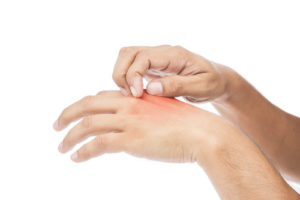Back to Main Page
Scabies is an itchy skin rash caused by a microscopic mite called Sarcoptes Scabiei. The mite burrows under the skin and lays eggs causing an intense itch and a skin rash. Scabies are contagious and are spread via direct or prolonged skin to skin contact as well as through contaminated clothing or bedding. Scabies spread rapidly and affect people of all race and social class (CDC, 2016).
Signs and symptoms of scabies
- Intense itching at night is the most common symptom. This is accompanied by a rash that is pimple-like.
- The itching and the rash can either affect the entire body or can be specific to elbows, wrists, between fingers, nipples, penis, and buttocks.
- The rash can include small blisters.
- If the skin is broken through scratching, it can cause sores on the skin which may become infected.
- The tiny mite burrows into the skin and can sometimes be seen on the body, most often around skin folds.

How soon do symptoms begin?
If this is the first time to ever have scabies, it can take between 4-6 weeks for the symptoms to begin. The person who is infested can spread the scabies during this time without noticing they have symptoms of scabies.
If this is not the first episode of scabies the symptoms can appear quicker, between 1 and 4 days after being exposed to the mite (CDC, 2016).
How do I get scabies?
Scabies can spread rapidly because people don’t realise they have them until 2-4 weeks after the infection has happened. Scabies can only move from one body to another if two people have direct contact for long periods of time, they can be transmitted by;
- Sharing a bed with a person who is infected
- Holding hands for long periods of time with a person who is infected
- Having sexual contact with a person who is infected
- Sharing bed linen, towels or clothing with a person who is infected
- In environments where people are in close proximity such as schools and colleges
There is a common misconception that scabies is caused by poor hygiene. No evidence suggests that this is true as scabies can affect all social classes, races etc. (HSE, 2016).
What do I do if I think I have scabies?
Scabies is usually treated with a lotion or cream. You can purchase it from pharmacy without a prescription, however it is better to see your nurse/doctor first. Medication that can also be taken orally to treat the associated itch. The treatment most commonly used -Permethrin- is recommended to be used twice, one week apart. Everyone should be treated at the same time so that mites do not pass back to a treated person (HSE, 2017).
Avoid all skin-to-skin contact to stop the spread.
Avoid unwashed clothing or bedding that person infected used.
Make sure to wash clothing, towel and bed covers in hot water.
Bleach down any surfaces that may contain scabies mites.
 Where to get help if I think I may have scabies?
Where to get help if I think I may have scabies?
You can call to the Student Health Centre where the nurse can make a diagnosis and begin treatment as soon as possible.
For further information click here.